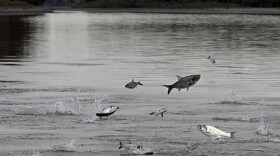Water experts worried about Asian carp may have new hope.
They’re turning their eyes to China, where a carp-hungry populace may be the key for stemming the tide of the invasive fish.
Asian carp are taking over U.S. waterways, including the Mississippi River and tributaries like the Illinois and Missouri Rivers, where they out-compete native fish.
In China, carp is cheap and a common meal-time fixture. Now, a carp fishing industry is springing up along carp-infested U.S. waters and processors are exporting the U.S. problem fish to Chinese diners.
Two Rivers Fisheries opened in Wickliffe, Ky., in 2013, near the point where the Ohio River flows into the Mississippi. Jeff Smith, the company’s operations manager, says his freezer is full of thousands of pounds of Asian carp.
“Ninety percent of what we sell is imported to China,” Smith said. “We’ve got some that will be going to Chicago and New York.”
Chinese customers like his carp, Smith said, because they are big. Most carp in China are farmed and grow to about two pounds. His fish weigh between 15 and 25 pounds.
“The taste is different,” Smith said. “Just like catfish that’s raised in a pond here, it doesn’t have the flavor that wild caught catfish does. It doesn’t have the intensity of the flavor.”
Last year, Two Rivers shipped 250 tons to China. This year, they hope to grow their exports to 2,000 tons.
Two Rivers’ owner Angie Yu markets her carp as “Kentucky White Fish” in China, a name that describes the meat color and ties it to another popular brand.
“Kentucky Fried Chicken is very famous in China,” Yu said. “Most of our fish is from that area so people know this is from Kentucky and that’s from America.”
Wild carp is hard to come by in China, but they are spreading like wildfire across American waterways, according to James Garvey, director for the Center for Fisheries, Aquaculture, and Aquatic Sciences at Southern Illinois University.
“This is a country-wide concern,” Garvey said. “We’re not talking about just the Midwest.”
Asian carp already make up more than half of the fish biomass in the lower Illinois River, according to some studies. In other words, Asian carp represent 60 percent of all the fish in the river, by weight. And Garvey thinks that number applies to other areas where they’re established.
“These fish, in every study that’s been done, have been shown that they can pretty much cover the entire United States,” Garvey said. “They’re already a problem in some of the western states. Minnesota is very concerned, Missouri is concerned. Nebraska, Kansas have had them and still have them.”
There’s an electric barrier on the Illinois River to keep them out of the Great Lakes and it has been successful so far, Garvey said. Other fixes include water guns, poisons and injecting carbon dioxide into the water, but those technologies aren’t ready yet.
“Harvest seems to be our only method right now for really taking these fish down,” Garvey said.
Still, the Asian carp industry is still in its infancy. There are a few other plants, mostly in Illinois. There is even one that makes Asian carp hot dogs. And fish research biologist Duane Chapman, with the U.S. Geological Survey in Columbia, Mo., says commercial fishermen have to catch a lot of Asian carp to make ends meet.
“It takes a lot of labor. It’s not something you pick up overnight,” Chapman said. “It’s hard to gear-up in terms of the number and skill level of the fishermen to do, too.”
The infrastructure to get the Asian carp catch to market, and on to China, isn’t quite there yet. Many fishermen have to travel for hours to get their catch to a processor.
Still, a Chinese market for a problem fish could continue to spur development. And while the Chinese market is the most promising right now, it doesn’t have to be that way.
“The fish as a fillet, they’re a little bony, but you can get around the bones because they’re really big,” Garvey said. “My preference is to cook them like a Thai style or a Chinese style where it’s with a lot of soy sauce or ginger or things like that. It’s pretty much the best fish I’ve ever had. Honestly. I’m not lying.”
Researchers and fishermen, though, will need a lot more adventurous American fish eaters to stem the tide of Asian carp.











